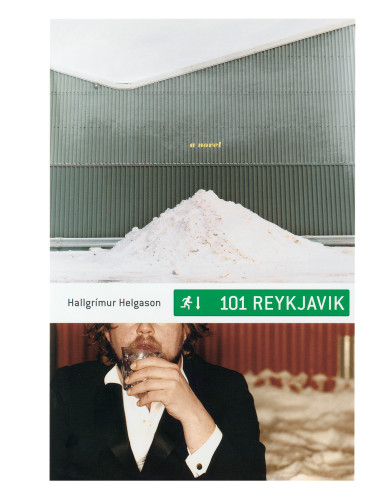 You’re supposed to read the book first. The movie is never as good and it will limit your imagination when you do read the book. I know this. But I watched Baltasar Kormákur’s movie, 101 Reykjavík, before I knew it was based on Hallgrímur Helgason’s novel. I really liked the movie. It felt a lot like an Icelandic Slackers; that’s the primary difference between the book and the movie.
You’re supposed to read the book first. The movie is never as good and it will limit your imagination when you do read the book. I know this. But I watched Baltasar Kormákur’s movie, 101 Reykjavík, before I knew it was based on Hallgrímur Helgason’s novel. I really liked the movie. It felt a lot like an Icelandic Slackers; that’s the primary difference between the book and the movie.
Book vs. Movies
The protagonist Hlynur Björn is hapless in the movie. In the novel he is hopeless. In one episode in the movie Slackers, we see the danger of a too-wired world when a character watches someone die and is bothered that the picture quality of real life was inferior to that on the screen (and this was before HD). But in general, Slackers was indulgent toward its useless characters. Hlynur carries his TV remote around town with him in case he needs to change the channel on real life, and even Hlynur knows it’s lame. Hlynur thinks of his life as a story, but only in the sense that everything is fake and contrived.
There is more plot in 101 Reykjavík than in Slackers (how could there not be?). The plot is darkly funny; Hlynur seems to do nothing but watch porn and get drunk but manages to wreak progressive havoc on the lives of the women around him.
The Icelandic Hero
Like many protagonists in Icelandic literature, Hlynur seems to be borderline autistic. Other characters’ inability to relate to people results from extreme shyness or serves to make them vulnerable; Hlynur just comes across as an asshole. Growing up with an alcoholic father and closeted mother is fair cause for hangups, but for Hlynur it seems to be an excuse to stay mostly dead. A couple hundred pages inside his head is oppressive, despite his clever word games.
Feel Lolla staring at me, like a camera. Feel my face adjusting to her as she focuses. Turn my head, look into her eyes. For a moment we’re just eyes. Two fish. Lolla’s eyes are ash gray. About the same amount of ash as on the tip of my cigarette. I stretch toward the ashtray and tap it.
Word Play
The word play in 101 Reykjavík is nonstop, and kept me going when I started to get fed up with Hlynur. Every sentence is somewhere between silly putty and a hackey sack. I wonder how much of it transfers directly from the Icelandic. How creative did translator Brian FitzGibbon have to be to recreate Hallgrímur’s original? Hlynur’s mind bounces around, sticking topics together in strange ways that sometimes flip the channel and sometimes reveal something profound.
In Light of Laxness
I can’t help but make comparisons with Halldór Laxness. (This statement alone is reason to read everything writes.) Like Laxness, Hallgrímur incorporates high and low references so frequently that few readers could catch them all. Like Laxness (less developed in early novels but still present), Hallgrímur has a dry humor that flies under the broad American radar. Also like many of Laxness’ books, I often found 101 Reykjavík a hard slog with an unpleasant companion. His characters are even more flawed than most of us, but he makes their stories significant when less capable hands would merely make them sordid. Clean readers beware.
His Other Work
This is the second of Hallgrímur Helgason’s books that I’ve read. The first was The Hitman’s Guide to Housecleaning. There are many similarities. Both protagonists are immoral; the hitman Tomas is more evil than Hlynur, and with greater cause, but seems to have a greater capacity for redemption. Both share a love for words, drawing the reader’s attention to them like unfamiliar objects that, once considered, do not allow one to proceed on the original course. In Hitman, the quiet suburb Kopavogur was transformed to Cop War by Tomas’ foreign ear.
Words
In 101 Reykjavík Hallgrímur could roam much further in his verbal associations.
I wake up in 1442. Same old story. Drag myself out of the coffin and rub the earth out of my eyes. Shamble about like a dumb medieval monk. In my black and white robe. Cheerios in the monastery. A Carmel Lite cigarette. Except I smoke Prince. Not a thought in my head. Just a turtle around my neck and smoke out of my mouth. A slight dizzy spell. As I break out of it, I suddenly get the feeling there’s nothing ahead of me but my next smoke. No more life ahead of me than a cigarette. 9.5 centimeters under my nose, 8, 7, 6, 5… I dread finishing it. What’ll I do when it’s finished? I try to smoke it sparingly and witness it slowly smoldering toward the filter. Not a thought in my head. I count the drags. Twelve drags in each cigarette. Twelve hours. Twelve apostles. Everything so calculated. Even cigarettes, each one designed to last the length of a song. First song of the day: “Losing My Religion,” R.E.M.
I get my best ideas when my mind wanders, and never can capture those reveries when I’ve got a computer in front of me. Hallgrímur has captured mental flow perfectly. Except it probably isn’t flow because every word in that paragraph (chosen bibliomantically) does double duty, working as hard as if the entire novel were a poem.
The Details
101 Reykjavík
Hallgrímur Helgason
Trans. Brian FitzGibbon
Scribner



About the author